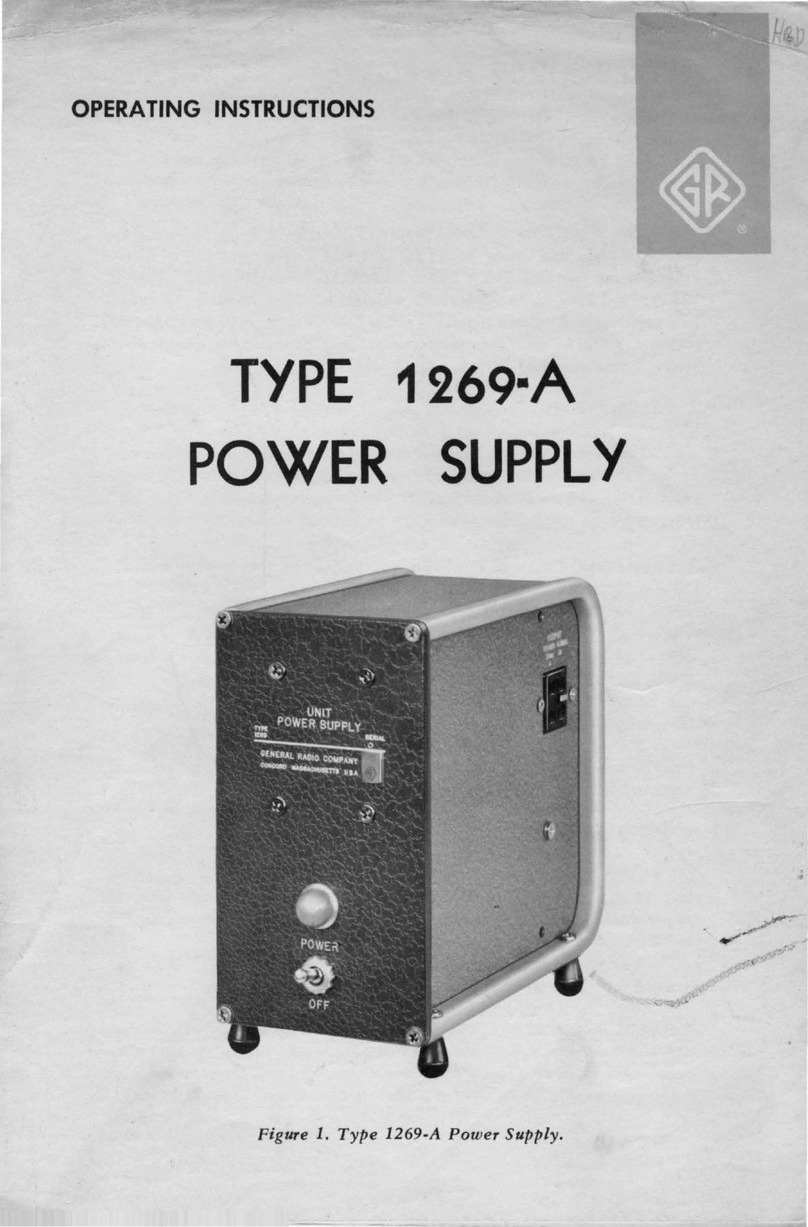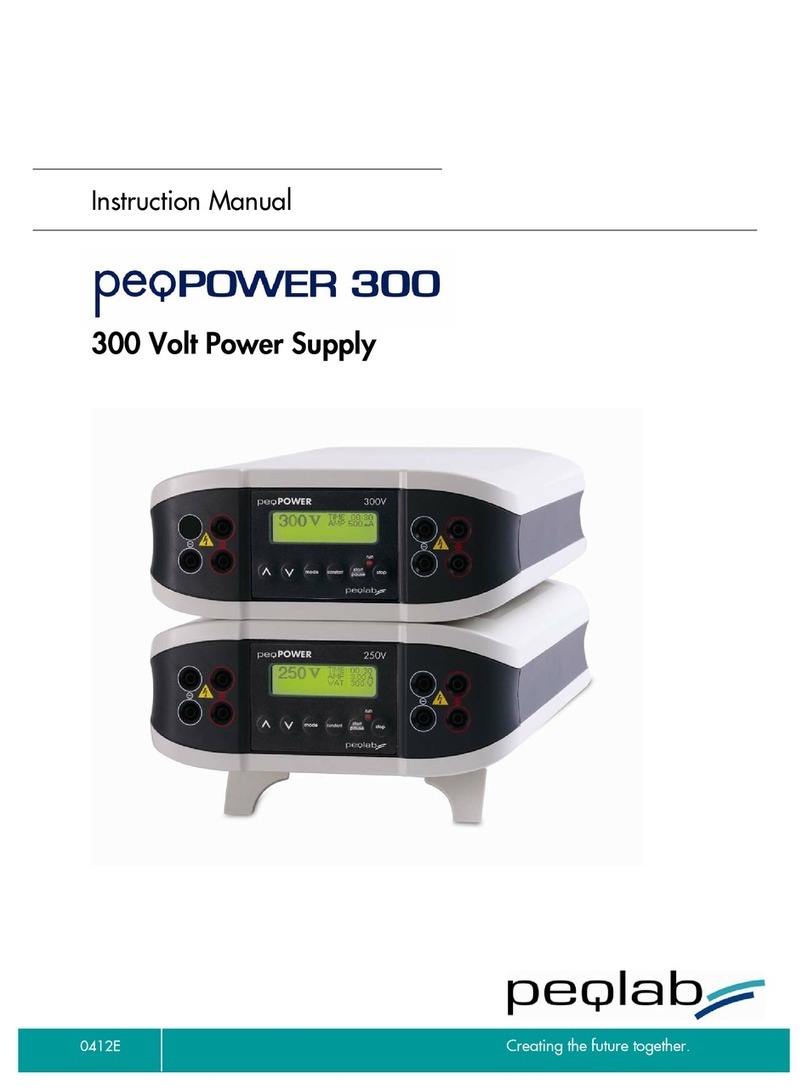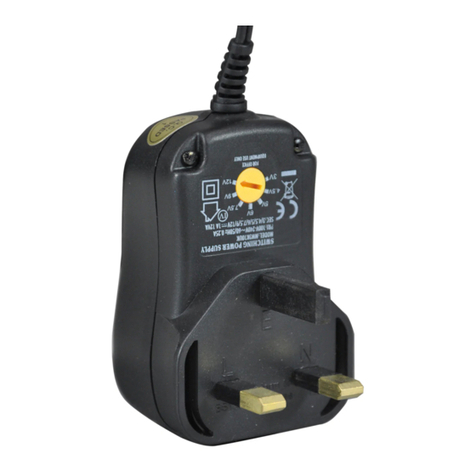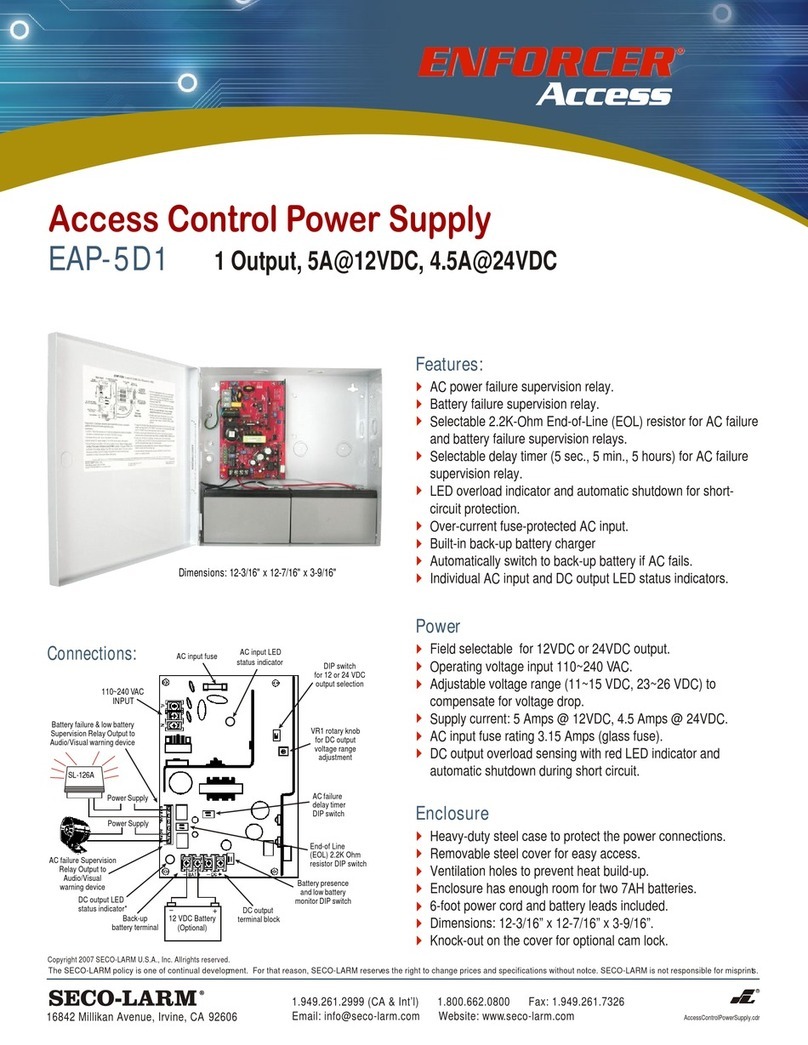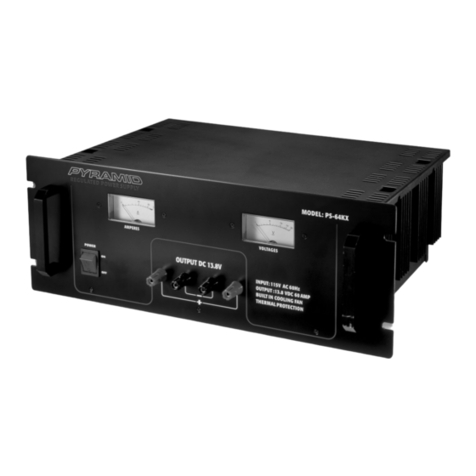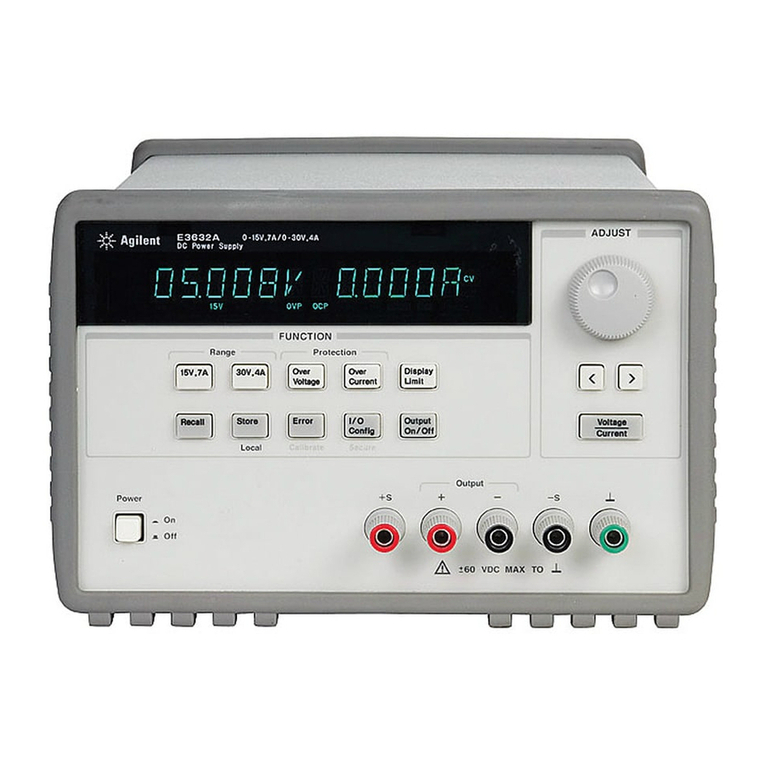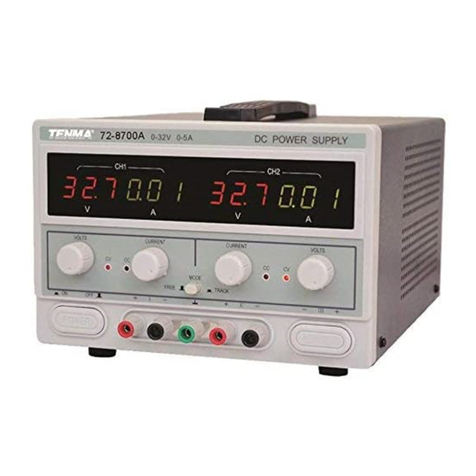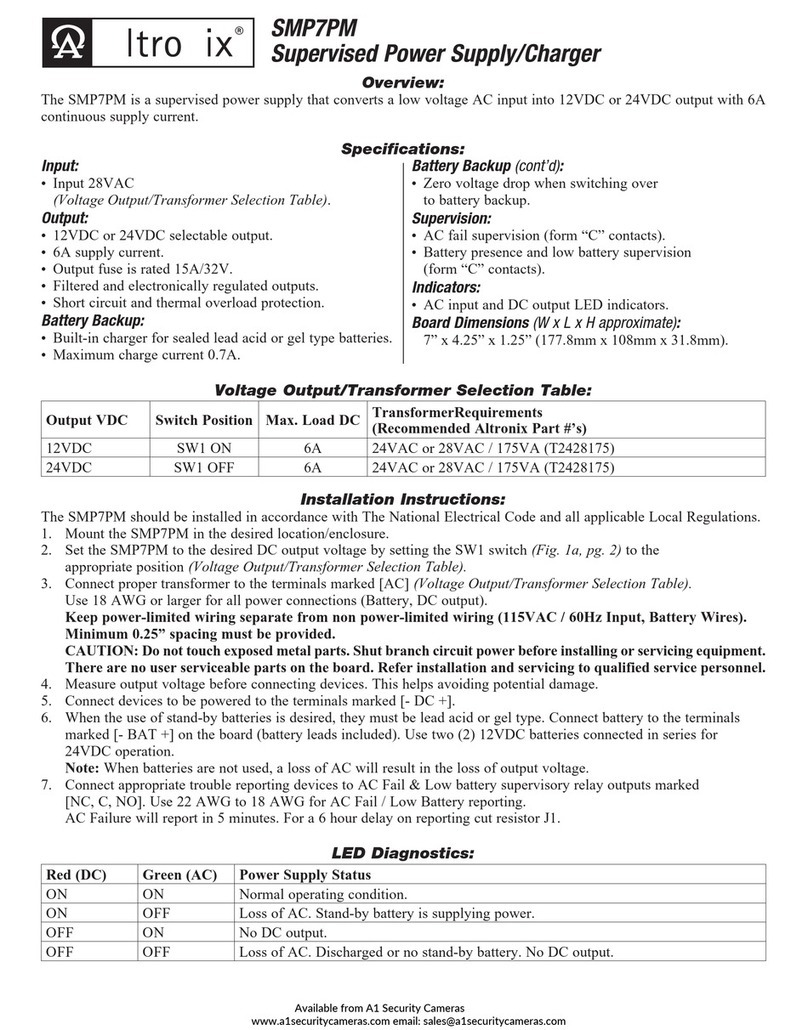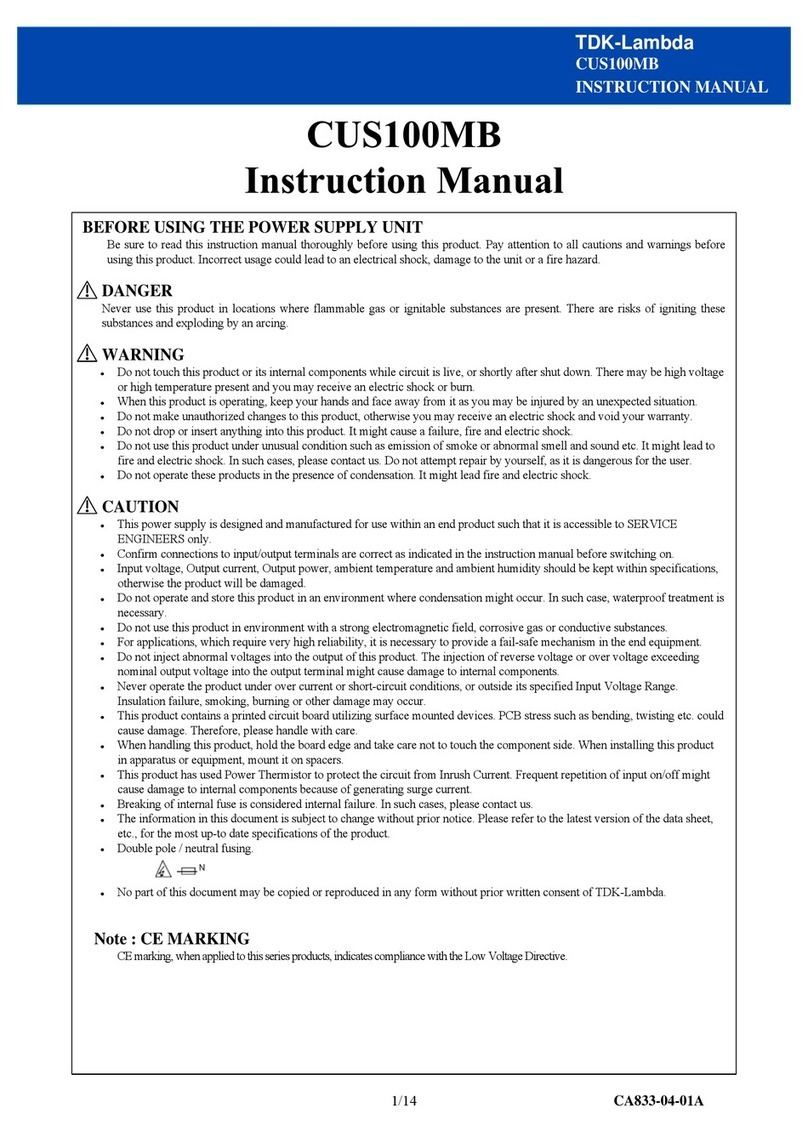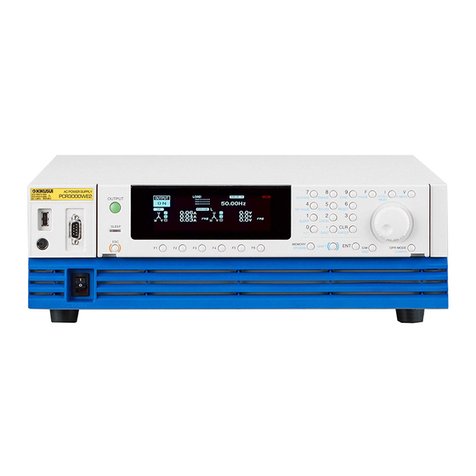GENERAL RADIO COMPANY 1263-8 User manual

OPERATING
INSTRUCTIONS
TYPE
1263-8
AMPLITUDE-REGULATING
POWER
SUPPLY
GCN£RAL
RADIO
COMP
A
NY
D

OPERATING INSTRUCTIONS
TYPE
1263-B
AMPLITUDE-REGULATING
POWER
SUPPLY
Form
1263-0110-D
July,
1962
GENERAL
RADIO
COMPANY
WEST
CONCORD,
MASSACHUSETTS,
USA

Copyright
1961 by
General
Radio
Company
West
Concord,
Massachusetts,
USA

Figure 1.
Panel
view
of1'ype
1263-IJ
Amplitude-Regulating
Power
Supply.

SPECIFICATIONS
Rf
Output
Voltage:
0.2
to
2.0
volts
behind
50 ohms for
any
recommended
oscillator
(see
below),
and
a
Type
874-VR
Voltmeter
Recti-
fier.
With 1-kc
square-wave
modulation,
0.2
to
1.0
volt
behind
50
ohms.
Rf
Output Regulation:
Below
500 Me,
rf
out-
put
of
recommended
Unit
Oscillators
is
held
to
within
±5%
including
the
effects
of
har-
monics.
This
regulation
can
be
attained
up
to
2000
Me
if
proper
low-pass
rf
filters
are
used
and
a
correction
applied
for
the
output-
rectifier
frequency
characteristic.
Modulation
Frequency:
1-kc
square-wave,
adjustable
±5%,
stable
to
within
5
cps
over
the
rated
range
of
line
voltage.
Duty
Ratio:
0.5
to
0.53,
adjustable
to
com-
pensate
for
oscillator
starting
delay.
Rise
and
Decay
Times:
50
f.Lsec
each.
Overshoot:
None.
Ramp-off:
Less
than
0.5%.
Gate
Voltage:
Synchronized
with
"off"
in-
terval
of
modulation,
exceeds
1
volt
into
the
the
recommended
load
of
30
k.O
shunted
by
300 pf.
Rise
and
decay
times
are
less
than
50
f.Lsec
each.
Gate
output
during
"on"
in-
terval
of
modulation
is
less
than
.01
volt.
Plate
Supply Output: 0
to
300
volts
at
30 ma.
Heater-Supply Output: 6 v ±10%
at
0.5
amp,
5.4v
±10%
at
0.7
amp.
Response Time:
For
a 2-to-1
step
variation
in
oscillator
output,
correction
is
completed
within
0.5
msec
with
cw
operation,
50
msec
with 1-kc
modulation.
Recovery
time
after
blanking
is
less
than
2
msec
with
cw
opera-
tion
less
than
200
msec
with
1-kc
square-
wave
modulation.
Hum
and
Noise:
Peak
residual
hum
and
noise
modulation
is
less
than
±0.3% on
cw;
less
than
±3%
with
1-kc
square-wave
modulation.
Output Voltmeter:
Internal
standardizing
cir-
cuit
is
provided.
Accuracy
after
standard-
ization
is
better
than
±10% of
indication
when
a
correction
is
applied
for
rectifier
characteristic
at
extremely
high
frequencies.
Tube Complement:
Four
12AX7,
one
each
5963,
6V6GT,
OA2.
Power Input: 105
to
125
(or
210
to
250).
volts,
50
to
60
cps,
55
watts
maximum,
at
full
load.
Accessories
Supplied:
Type
CAP-22
Three-
Wire
Power
Cord,
connector
cable
for modu-
lation
jack
on
oscillator,
spare
fuses.
Other
Accessories
Required:
Type
874-VR
Voltmeter
Rectifier,
Type
874-R22
Patch
Cord
for
connecting
output
rectifier,
and
Type
874-T
for
monitoring
oscilloscope
connection
in
sweeping
applications.
Recommended
Oscillators:
Type
1215·B
(50
to
250 Me),
Type
1209-BL
(180
to
600 Me),
Type
1209-B
(250
to
920 Me),
Type
1361-A
(450
to
1050 Me),
Type
1218-A
(900
to
2000
Me),
and
for
cw
operation
only
Type
1211-B
(0.5
to
50 Me).
Other
Accessories
Available:
The
Type
1750-A
Sweep
Drive
is
recommended
for
auto-
matic
operation.
Coaxial
Cables,
connectors,
attenuato;s,
filters,
adaptors,
and
relay-rack
adaptor
panels
are
available.
Mounting: Aluminum
panel
and
cabinet.
Dimensions: Width
8,
height
7,
depth
9XI
inches
(205
by
180
by
235 mm),
over-all.
Net
Weight:
14~
pounds
(6.6
kg).

Section
1
INTRODUCTION
1.1
PURPOSE.
The
Type
1263-B
Amplitude-Regulating
Power
Supply
(Figure
1)
is
designed
to
operate
General
Radio
Unit
Oscillators
or
oscillators
with
similar
power
requirements.
This
power
supply
automatically
adjusts
the
plate
current
supplied
to
an
oscillator
to
maintain
the
rf
output
volt-
age
at
a
constant
preset
level.
This
constant
output
is
of
great
advant-
age
in
frequency-response
measurements,
:;~nd
is
particularly
important
when
the
oscillator
frequency
dial
is
mechanically
swept
for
use
with an
oscilloscope
or
recorder.
The
oscillator
must
have
suitable
connections
for
application
of
a
modulating
voltage
(as
have
Genera
l
Radio
Unit
Os-
cillators).
There
must
also
be
available
an
output
rectifier
to
supply
a
negative
de
potential
proportional
to
the
oscillator
rf
output.
In
Figure
2, a
Type
1263
-B
Amplitude-Regulating
Power
Supply
is
shown
with a
Type
1750-A
Sweep
Drive,
driving
a
Type
1209-B Unit
Oscillator.
The
Type
1263-B
Amplitude-Regulating
Power
Supply
was
designed
especially
for
use
with
oscillators
driven
by
the
Type
1750-A.
It
is
equally
useful
with
the
Types
907-R
and
908-R
Dial
Drives
(see
paragraph
1.3.6)
and
with
manually
operated
oscillators.
For
most
swept
-
frequency
applications,
cw
operation
is
desirable
because
fast
regulating
action
is
possible.
However,
in
this
instrument,
Figure
2.
Type
1263-B
Amplitude-Regulating
Power
Supply
and
Type
1750-A
Sweep
f>rive
shown
driving
a
Type
1209-H Unit
Oscillator.

GENERAL
RADIO
COMPANY
internal
1-kc
off-on
modulation
is
provided
for
use
with
a
sensitive
de-
tector
such
as
an
rf
demodulating
rectifier
followed
by
a
1-kc
selective
amplifier.
The
Type
1263-B
also
supplies
heater
voltage
to
the
oscillator.
Output
voltage
and
current
specifications
are:
plate
supply,
0
to
300
volts
at
30 rna;
heater
supply,
6
volts
at
0. 5
amp.
1.2
DESCRIPTION.
1.2.
1
CONTROLS.
The
following
controls
are
on
the
Type
1263-B
Am-
plitude-Regulating
Power
Supply:
Name
POWER
ZERO
CAL
OUTPUT
VOLTAGE
ADJ
MOD
FREQ
INCREASE
DUTY
RATIO
Description
Positions
Two-position
POWER,
OFF
toggle-switch
with
pilot
light
Two-position
toggle-switch
Five-position
selector
switch
Recessed
thumb-set
control
Recessed
thumb-set
control
Continuous
rotary
control
Continuous
rotary
control
Recessed
thumb-set
control
CW-1
kc
rLJ
MOD
ZERO,
CHECK
CAL,
OPERATE
UN
REG
2
Function
Turns
power
on
or
off.
Selects
cw
or
1-kc
square-
wave
modulation.
Permits
output
voltmeter
to
be
checked
and
calibrated
with
output
rectifier
in
use,
without
disturbing
any
con-
nections
to
oscillator,
and
switches
off
amplitude
con-
trol.
Output-voltmeter
zero
ad-
justment.
Output-voltmeter
calibra-
tion
adjustment.
Sets
output
level.
Adjusts
modulating
fre-
quency
over
narrow
range.
Permits
symmetrical
square-
wave
modulation
even
with
appreciable
starting
delay
in
oscillator.

TYPE
1263-B
AMPLITUDE-REGULATING
POWER
SUPPLY
1.2.2
CONNECTORS.
The
following
connectors
are
on
the
Type
1263-B
Amplitude-Regulating
Power
Supply:
Name
Description
Function
POWER
Four-terminal
Direct
plug-in
connection
for
power
socket
cables
of
General
Radio
Unit
Oscilla-
tors.
MODULATION
Two-terminal
Connection
to
modulation
terminals
of
plug
oscillator.
For
General
Radio
Unit
Os·
cillators,
connection
is
via
patch
cord
with
two-terminal
socket
on
one
end
and
telephone
plug
on
other
end.
OUTPUT
Recessed
Center
conductor
connects
to
output
RECTIFIER
Type
874
rectifier,
shield
connects
to
output-rec·
Coaxial
tifier
ground.
Connector
BLANKING
Telephone-
Connection
for
an
external
contactor
to
tip
jacks
blank
or
cut
off
oscillator
output.
Used
(two)
in
sweep
applications
to
eliminate
re-
turn
trace
and
provide
a
zero
reference
base
line
on
sweep
display.
GATE
Phone
jack
Modulation-gate
output
for
use
with
syn-
chronous
demodulator
system.
Three·termi-
Connection
for
ac
power,
through
de·
nal
plug.
tachable
line
cord.
1.2.3
METER.
The
OUTPUT
VOLTAGE
meter
indicates
theoutput
volt-
age,
and
is
the
means
of
checking
the
regulating
action
of
the
power
sup-
ply.
The
meter
is
an
internal
de
vacuum-tube
voltmeter,
calibrated
in
volts
of
rf
output.
The
quasilogarithmic
scale
covers
a
range
from 0
to
2
volts.
An
internal
calibration
circuit
permits
the
meter
to
be
standard-
ized
with
a
particular
output
rectifier.
By
means
of
a
panel
selector
switch,
calibration
and
zero
adjustments
(thumb-set
controls;
refer
to
paragraph
1.2.1)
can
be
made
quickly
without
disturbing
connections
to
the
oscillator.
1.2.4
FUSES.
Line
fuses
are
accessible
from
the
left-hand
side
of
the
instrument.
Slow-blow
0.8-ampere
fuses
are
used
for
115-volt
operation,
and
slow-blow
0.4-ampere
fuses
are
used
for
230-volt
operation.
3

GENERAL
RADIO
COMPANY
1.3
ASSOCIATED
EQUIPMENT.
1.3.1
UNIT OSCILLATOR.
The
following
is
a
list
of
recommended
Gen-
eral
Radio
Unit
Oscillators:
Type
No.
1211-B*
1215-B
1209-BL
1209-B
1361-A
1218-A**
Frequency
Range
0.5
to
5 Me; 5
to
50
Me
50
to
250
Me
180
to
600
Me
250
to
920
Me
450
to
1050
Me
900
to
2000
Me
An
earlier
"A"
model
of
the
Type
1211, 1215,
or
1209
Unit
Oscil-
lator
will
operate
satisfactorily
with
the
Type
1263-B
Amplitude-Regu-
lating
Power
Supply
if
the
telephone
plug
is
removed
from
the
modulation
cable
or
is
adapted
to
connect
to
the
screw-terminals
on
the
oscillator.
Types
1208-A
and
-B
Unit
Oscillators
cannot
be
used
with
the
Type
1263-B
Amplitude-Regulating
Power
Supply.
Other
oscillators
with
suit-
able
power
requirements
can
be
operated
from
this
power
supply
if
a
de
connection
can
be
made
to
the
cathode
circuit
to
apply
plate-current
control.
1.3.2 OUTPUT RECTIFIER.
The
General
RadioType
874-VR
Voltmeter
Rectifier
is
recommended
for
use
as
the
output
rectifier
over
the
frequency
range
of
0.5
to
2000 Me.
It
can
be
plugged
directly
into
the
output
con-
nector
of
General
Radio
Unit
Oscillators,
and
provides
a
matched
source
for 50-ohm
coaxial
cable.
The
backresistance
of
the
crystaldiode
should
exceed
40,000
ohms.
The
ripple
in
the
output
of
the
rectifier
must
be
less
than
10
percent
at
frequencies
above
0.
5
Me
to
prevent
overloading
the
con-
trol
amplifier;
this
condition
is
satisfied
when
a
Type
874-VR
with
a
good
crystal
diode
is
used.
With
the
Type
874-VR
Voltmeter
Rectifier,
there-
sponse
time
is
essentially
determined
by
the
internal
compensation
in
the
power
supply.
The
stability
of
the
control
system
(freedom
from
hunting
and
oscillation)
is
established
by
this
compensation.
1.3.3 OUTPUT
FILTER.
To
minimize
errors
due
to
oscillator
harmon-
ics,
a
low-pass
filter
can
be
used
between
the
oscillator
output
and
the
output
rectifier
(refer
to
Section
5).
The
following
General
Radio
filters
are
recommended:
Type
87
4-F 185
Type
87
4-
F 500
Type
874-F1000
Type
874-F2000
•
Not
recommended
for
modulated
operation
•
185-Mc
Low-Pass
Filter
500-Mc
Low-Pass
Filter
1000-Mc
Low-Pass
Filter
2000-Mc
Low-Pass
Filter
..
For
both
cw
and
square-wave
modulated
operation
with
the
Type
1263-B,
set
the
Type
1218-A
selector
switch
to
CW.
4

TYPE 1263-B AMPLITUDE-REGULATING
POWER
SUPPLY
1.3.4 MATCHED DETECTOR.
In
setups
for
measuring
transmission
or
frequency
characteristics
of
various
elements
and
networks,
a
Type
874-VQ
Voltmeter
Detector,
terminated
in
a
Type
874-WM
Termination
Unit,
can
be
used
at
the
output
of
the
unknown
to
measure
the
output
signal.
The
Type
874-VQ
Voltmeter
Detector
is
similar
to
the
Type
874-VR
Voltmeter
Rectifier
(paragraph
1. 3.2),
except
that
it
does
not
contain
a
series
50-ohm
resistor
and
does
contain
compensating
elements
to
min-
imize
discontinuity
produced
by
the
shunt
reactance
of
the
crystal
diode.
A
block
diagram
of
the
set-up
for
plotting
frequency
characteristics
of
a
Type
874-F185
Low-Pass
Filter
is
shown
in
Figure
3. In
this
diagram,
the
output
of
a
Type
1215-B
Unit
Oscillator,
regulated
by
the
Type
1263-B
Amplitude-Regulating
Power
Supply,
is
fed
through
the
output
rectifier
(874-VR)
to
the
device
under
test
(874-F185).
The
output
from
the
de-
vice
under
test
is
detected
by
the
properly
terminated
Type
874-VQ
Volt-
meter
Detector
and
the
characteristics
are
plotted
on
an
x-y
plotter.
1.3.5
SWEEP
DRIVE.
The
General
Radio
Type
1750-A
Sweep
Drive
can
be
used
with
oscillators
operating
from
the
power
supply
to
produce
a
sweeping
frequency
source
with
constant
rf
output
over
the
sweep
range.
This
sweep
drive
also
has
a
blanking
voltage
and
provides
a
cathode-ray-
oscilloscope
deflection
voltage
synchronized
with
the
position
of
the
driven
dial.
1.3.6
DIAL
DRIVE.
For
permanent,
precise
recording
of
data,
a two-
axis
plotter
is
an
invaluable
accessory.
The
General
Radio
Types
907-R144
and
908-R96
Dial
Drives
are
designed
to
sweep
equipment
using
stand-
ard
General
Radio
4-inch
(Type
907-R
Drive)
and
6-inch
(Type
908-R
Drive)
dials.
The
Type
1263-B
Amplitude-Regulating
Power
Supply,
used
with
any
of
the
oscillators
listed
in
paragraph
1.3.1,
will
provide
a
TYPE
1263-B
AMPLITUDE
REGULATING
POWER
SUPPLY "y" AXIS
SIGNAL
!
DEVICE
I
UNDER
TEST
TYPE TYPE TYPE TYPE TYPE
1215-B
r-
874-VR
r-
874
-F185
-
874-VQ
1--
874-WM
XY
UNIT
VOLTMETER
LOW
PASS
VOLTMETER
5011
PLOTTER
OSCILLATOR
RECTIFIER
FILTER
DETECTOR TERMINATION
).-
i
TYPE
"X"
AXIS SIGNAL
DC
908-R96
-
SUPPLY
DIAL
DRIVE
Figure 3.
Typical
setup
for
plotting
frequency
characteristics.
5

GENERAL
RADIO
COMPANY
constant
output
voltage
in
order
that
the
final
recording
will
be
a
direct
indication
of
relative
response.
In
the
block
diagram
of
Figure
3, a
Type
908-R96
Dial
Drive
is
shown
driving
a
Type
1215-B
Unit
Oscillator,
with
the
detected
output
of
a
low-pass
filter
plotted
by
an
x-y
plotter.
1.3.7 SENSITIVE DETECTOR. A
Type
874-VQ
Voltmeter
Detector
fol·
lowed
by
a
Type
1232-A
Tuned
Amplifier
and
Null
Detector
tuned
to
1
kc
be
used
for
increased
detector
sensitivity
when
1-kc
modulation
from
the
Type
1263-B
is
applied
to
the
oscillator.
Section 2
THEORY OF
OPERATION
2.1
GENERAL.
In
the
cw
mode
of
operation,
the
Type
1263-B
Amplitude-Regu-
lating
Power
Supply
compares
the
de
potential
developed
by
the
oscil-
lator
output
rectifier
with
a
de
reference
potential,
and
applies
a
correction
to
the
oscillator
plate
supply
to
minimize
the
difference.
The
load
re-
sistance
presented
to
the
output
rectifier
is
100,000
ohms.
A maximum
of 300
volts
at
30
milliamperes
is
available
for
the
oscillator
plate.
The
de
reference
potential
is
adjustable
from 0
to
2.5
volts,
which
corre-
sponds
to
an
rf
output
of 0
to
2
volts
with
the
normal
output
rectifier.
This
power
supply
will
maintain
any
preset
level
within
2
percent
over
the
frequency
range
(subject
to
additional
variations
due
to
harmonics
and
possible
errors
of
the
output
rectifier),
provided
that
the
oscillator
produces
at
least
2
volts
with
a
300-volt,
30-milliampere
plate
supply
at
all
frequencies
within
its
range.
-In
the
1-kc
modulated
mode
of
operation,
the
regulating
action
is
maintained
and
the
carrier,
or
average
rf,
level
is
controlled.
This
level
is
one-half
the
"on"
level
of
the
rf-modulated
output.
Carrier
output
is
limited
to
1
volt
with
the
recommended
oscillators.
6

TYPE
1263-B
AMPLITUDE-REGULATING
POWER
SUPPLY
2.2 CIRCUIT.
The
elementary
schematic
diagram
(Figure
4)
illustrates
the
prin-
ciples
of
operation's
of
the
power
supply.
The
output
rectifier
develops
a
negative
de
potential
proportional
to
the
rf
amplitude
at
the
oscillator
output.
This
potential
is
applied
to
the
voltmeter
amplifier
and
to
one
grid
of
the
first
difference
amplifier.
An
adjustable
negative
reference
potential
is
applied
to
the
other
grid
of
the
first
difference
amplifier.
An
increase
in
the
negative
potential
developed
by
the
output
rectifier,
with
respect
to
the
reference
potential,
is
amplified
by
the
two
difference
am·
plifiers,
and
appears
as
an
increased
negative
potential
at
the
output·
amplifier
grid.
This
reduces
the
plate
current
supplied
to
the
oscillator.
Conversely,
a
decrease
in
output
produces
an
increase
in
plate
current
applied.
This
closed-circuit
feedback
system
holds
the
output
close
to
a
preset
level.
An
external
contactor
shorts
the
reference
potential
to
effect
rf
blanking.
With
internal
1-kc
square-wave
modulation,
the
regulating
action
described
above
continues
except
that
an
RC
filter
is
switched
in
to
pass
only
the
average
de
from
the
output
rectifier,
and
the
plate
supply
is
interrupted
with
a
1-kc
square
wave.
Under
these
conditions,
the
average
or
carrier
level
of
the
oscillator
output
voltage
is
regulated.
Variable
resistors
in
the
1-kc
multivibrator
circuit
permit
adjustment
of
the
fre·
quency
and
duty
ratio
of
the
square-wave
modulation
over
a
narrow
range.
For
cw
operation,
the
multivibrator
is
biased
to
the
"on"
state
and
mod-
ulation
ceases.
Figure
4. EleT(lentary
Schematic
for
Type
1263-B
Amplitude-Regulating
Power
Supply.
1
....
,..,...~
..
,...
I
I
I
I T
L
________
J
I
-250v
I
I_
50v
:
1-150¥
L-----------------------------------------------------------J
-2.50v
-;_
_
_J~
7

GENERAL
RADIO
COMPANY
2.3
RESPONSE
TIME.
In
swept-frequency
applications,
rapid
variation
of
oscillator
out-
put
is
likely
to
occur,
particularly
in
the
uhf
range.
This
variation
can
be
nearly
eliminated
by
the
Type
1263-B
Amplitude-Regulating
Power
Supply.
Cw
operation
is
recommended
for
most
sweeping
applications
since
the
most
rapid
regulator
response
is
obtained
in
this
mode. With
cw
operation
the
Type
1263-B
will
correct
a 2-to-1
step
of
oscillator
out·
put
voltage
in
less
than
0.5
millisecond.
If
blanking
is
applied
by
shorting
contacts
in
the
sweep-drive
mechanism,
regulation
is
restored
within
2
milliseconds
after
blanking
is
removed.
With
internal
1-kc
square-wave
modulation
the
response
and
recovery
times
of
the
power
supply
are
in-
creased
to
about
50
and
200
milliseconds,
respectively.
With
cw
operation
the
recommended
General
Radio
Unit
Oscillators
can
be
swept
through
their
entire
ranges
in
less
than
one-half
second
with
satisfactory
regulation.
To
ensure
complete
regulation
with
modu-
lation,
the
entire
ranges
of
the
oscillators
should
not
be
swept
in
less
than
10
seconds,
although
good
regulation
can
be
obtained
over
most
of
the
ranges
with
a
sweep
time
as
low
as
two
seconds.
Section
3
INSTALLATION
3.1
CONNECTIONS.
(Refer
also
to
Section
1.3.)
3.1.1
POWER
AND
MODULATION
CONNECTIONS.
Plug
the
Unit
Os-
cillator
power
cable
into
the
multipoint
connector
on
the
right-hand
side
of
the
power
supply.
With
the
patch
cord
supplied,
connect
the
MODU-
LATION
plug
on
the
power
supply
to
the
modulation
jack
of
the
Unit
Os-
cillator.
CAUTION
Excessive
voltage,
even
if
applied
for a
short
time,
can
damage
crystal
diodes.
Do
not
apply
ac
power
to
the
power
supply
until
all
connectio.ts
between
oscil-
lator,
output
rectifier,
and
power
supply
have
been
made. When
using
the
Type
1211-B
Vnit
Oscillator.
tum
the
selector
switch
on
the
power
supply
to
ZERO
while
changing
frequency
range.
8

TYPE
1263-B
AMPLITUDE-REGULATING
POWER
SUPPLY
3.1.2
OUTPUT-RECTIFIER
CONNECTION. With a
Type874-R22
Patch
Cord,
connect
the
OUTPUT
RECTIFIER
connector
of
the
Type
1263-B
to
the
de
output
(side
connector)
of
the
Type
874-VR
Voltmeter
Rectifier.
The
Type
874-VR
should
be
connected
as
close
as
possible
to
the
output
connector
of
the
oscillator,
either
by
direct
plug-in
or
with
an
output
filter
interposed
(refer
to
Section
5).
The
resistor
end
marked
R
should
face
the
load
to
provide
a
matched
source
for a 50-ohm
coaxial
line.
A
Type
874-EL
90
°
Ell
and
Type
874-Z
Stand
are
useful
acces-
sories
for
connecting
and
supporting
the
output
filter
and
Type
874-VR.
Adaptors
are
available
for
connectors
other
than
Type
874.
Refer
to
the
table
of
Type
874
Accessories
at
the
rear
of
this
manual.
3.2
HEATER-SUPPLY
VOLTAGE
ADJUSTMENT.
There
is
a
considerable
variation
in
the
heater-current
require-
ments
of
the
various
Unit
Oscillators.
A
compromise
in
voltage
supplied
permits
satisfactory
operation
without
adjustment.
Output
is
6
volts
at
0.5
ampere
with
the
nominal
line-supply
voltage.
Heater-current
require-
ments
for
oscillators
are
met
as
follows:
a.
Types
1209-BL,
1209-B,
and
1215-B:
6.3
volts
at
0.3
to
0.4
am-
pere.
b.
Type
1211-B:
5.4
volts
at
0.7
ampere
satisfactory
(nominal
re-
quirement
is
6
volts
at
0.75
ampere).
c.
Type
1218-A:
has
internal
heater
rectifier.
Polarity
of
de
sup-
plied
by
Type
1263-B
Power
Supply
is
chosen
so
that
this
rectifier
con-
ducts.
Oscillator
current
requirement
is
less
than
0.2
ampere.
The
drop
in
the
rectifier
and
associated
filter
is
such
that
proper
voltage
is
sup-
plied
to
the
tube.
d.
Type
1361-A: 7
volts
at
135 rna.
Voltage
drop
within
the
oscil-
lator
reduces
the
voltage
at
the
tube
to
6.7
volts,
which
is
satisfactory
for
normal
use.
If
the
Type
1263-B
Power
Supply
is
to
be
used
only
with
the
Type
1361-A
Oscillator,
remove
the
jumper
as
described
below.
e.
Oscillators
requiring
less
than
0.2
ampere
at
6.3
volts:
Remove
the
jumper
that
connects
the
terminals
of
the
electrolytic
capacitor
at
the
top
center
of
the
Type
1263-B.
This
jumper
is
accessible
from
the
rear
after
the
dust
cover
and
V2
are
removed.
9

GENERAL RADIO COMPANY
Section 4
OPERATING
PROCEDUR1E
4.1
INITIAL
ADJUSTMENT.
After
the
proper
connections
have
been
made
to
the
oscillator
and
the
output
rectifier
(refer
to
paragraphs
1.3
and
3.1),
apply
power,
allow
at
least
a
2-minute
warm
up,
and
check
operation
as
follows:
a.
Standardize
the
output
voltmeter.
(1) With
the
selector
switch
in
the
ZERO
position,
turn
the
ZERO
thumb-set
control
to
zero
the
meter.
(2)
Turn
the
selector
switch
to
CHECK
and
observe
the
meter
in-
dication.
(3)
Turn
the
selector
switch
to
CAL
and
turn
the
CAL
thumb
con-
trol
to
produce
the
same
indication
as
noted
in
(2).
b.
Turn
the
selector
switch
to
OPERATE.
c.
Select
CW
or
1-KC
ru
MOD.
d.
Set
the
OUTPUT
VOLTAGE
control
so
that
the
desired
operating
voltage
is
indicated
on
the
meter.
If
it
is
impossible
to
reach
this
level
by
advancing
the
OUTPUT
VOLTAGE
control,
the
oscillator
cannot
sup-
ply
this
output.
As
the
normal
oscillator
output
coupling
is
reduced,
the
drop-out
point
of
the
regulator
will
occur
abruptly,
with
no
noticeable
change
in
level
down
to
this
point,
if
the
system
is
operating
properly.
If,
with
normal
plate
supply,
the
output
from
the
oscillator
is
much
greater
than
desired,
the
control
system
may
become
unstable
and
break
into
oscillation.
This
condition
can
easily
be
observed
by
the
action
of
the
output
meter
as
the
oscillator
output
coupling
is
varied.
As
the
coupling
(control
or
loop
on
the
oscillator
itself)
is
increased
from
the
minimum
setting,
the
indicated
voltage
should
rise
to
the
desired
output
level,
then
remain
constant
over
a
part
of
the
range
of
the
oscillator
out-
put
coupling.
Then,
if
the
coupling
can
be
advanced
far
enough,
the
meter
will
suddenly
jump
up
or
down,
indicating
the
unstable
oscillating
condition.
All
General
Radio
Unit
Oscillators
are
equipped
with
an
ad-
justable
output
coupling
system,
so
that
the
above
tests
can
be
made.
Once
the
adjustments
have
been
made,
it
should
be
possible
to
turn
the
oscillator
dial
through
the
entire
frequency
range
with
no
noticeable
fluc-
tuation
in
output
voltage.
10

TYPE
1263-B
AMPLITUDE-REGULATING
POWER
SUPPLY
4.2
SWEEP
APPLICATIONS.
If
the
oscilfator
is
mechanically
swept
for
automatic
frequency
re-
sponse
displays,
the
dynamic
regulation
of
the
output
should
be
checked.
A
cathode-ray
oscilloscope
used
to
present
the
response
is
an
excellent
means
of
checking
the
operation
of
the
power
supply
and
of
observing
when
optimum
output-coupling
setting
is
obtained.
When
the
Type
1750-A
Sweep
Drive
is
used,
connect
the
blanking
cable
to
the
BLANKING
tele-
phone-tip
jacks
on
the
Type
1263-B
Amplitude-Regulating
Power
Supply
to
provide
a
zero-reference
base
line
for
the
desired
response
display
and
for
the
checking
display.
The
horizontal
input
to
the
oscilloscope
should
be
supplied
with
the
oscilloscope
sweep
voltage
provided
by
the
sweep
drive.
Temporarily
insert
a
Type
874-T
in
the
cable
to
the
out-
put
rectifier
and
connect
the
vertical
input
of
the
oscilloscope
to
the
connector
thus
made
available.
The
oscilloscope
should
be
set
for
de
response.
Such
changes
in
connection
can
be
made
without
turning
the
power
supply
off,
provided
that
the
selector
switch
is
set
to
ZERO.
Re-
turn
the
selector
switch
to
OPERATE.
Drive
the
oscillator
over
the
de-
sired
level.
Adjust
oscilloscope
sensitivity
to
give
a
suitable
horizontal
and
vertical
deflection.
For
cw
operation,
the
pattern
should
be
approx-
imately
rectangular,
with
the
horizontal
portions
straight
lines.
The
neg-
ative
voltage
horizontal
portion
represents
the
oscillator
output
char-
acteristic,
and
the
positive
portion
the
zero
level.
With
1-kc
internal
modulation
a
similar
pattern
is
obtained
except
that
the
horizontal
portions
are
traced
out
by
two
bright
spots
connected
by
a
vertical
line.
The
flatness
of
the
path
traced
by
the
lower
spot
is
the
indication
of
flatness
of
the
oscillator
output.
Since
the
average
value
of
the
modulated
output
is
regulated,
variation
in
starting
delay
in
the
oscillator
over
its
frequency
range
will
cause
variations
in
the
duty
ratio
of
the
square
wave
and
consequently
show
a
variation
from
flatness.
The
use
of
a
matched
termination
or
resistance
pad
following
the
output
rectifier
will
minimize
variation
of
oscillator
starting
delay.
If
the
oscillator
output
characteristic
is
not
shown
as
a
horizontal
straight
line,
adjust
the
oscillator
output
coupling,
and,
if
necessary,
re·
duce
sweep
speed.
A
broadening
or
burst
of
high-frequency
voltage
on
this
line
indicates
control-system
oscillation;
to
eliminate
this,
reduce
the
output
coupling.
For
best
regulation,
some
readjustment
of
the
os-
cillator
output
coupling
is
necessary
with
changes
in
the
setting
of
the
OUTPUT
VOLT
AGE
control,
particularly
with
internal
1-kc
modulation.
Sharp
discontinuities
in
the
output
characteristic
of
the
oscillator,
particularly
when
wide
frequency
ranges
are
swept,
may
require
a
reduction
in
sweep
speed
so
that
the
control-system
response
time
will
permit
com-
plete
correction
of
output
voltage.
With
General
Radio
Unit
Oscillators
11

GENERAL RADIO COMPANY
and
cw
operation
this
reduction
will
not
exceed
the
low-speed
limit
im-
posed
by
mechanical
standards.
Once
a
flat
horizontal
line
representing
the
oscillator
output-volt-
age
characteristic
is
obtained,
the
oscilloscope
vertical
input
can
be
transferred
to
the
device
under
test
with
the
assurance
that
the
output
voltage
is
being
regulated
by
the
Type
1263-B.
4.3 INTERNAL AMPLITUDE MODULATION.
In
addition
to
the
toggle
switch
that
selects
either
CW
or
1-KC nJ
MOD,
there
are
two
controls
for
internal
modulation.
If
a
1-kc
fixed-fre-
quency
selective
audio
amplifier
is
used
with
a
demodulating
detector,
adjust
the
modulating
frequency
for maximum
response
with
the
ADJ
MOD
FREQ
control.
For
a
symmetrical
modulation.
waveform,
monitor
the
de-
modulated
output
on
an
oscilloscope
and
adjust
the
duty
ratio
with
the
INCREASE
DUTY
RATIO
thumb-set
control
on
the
left-hand
side
of
the
Type
1263-B.
If
a
gate
voltage
is
desired
for
keying
a
synchronous
de-
modulator
or for
other
synchronizing
purposes,
connect
to
the
GATE
out-
put
with
a
standard
telephone
plug.
4.4 EXTERNAL AMPLITUDE MODULATION.
Although
the
Type
1263-B
Amplitude-Regulating
Power
Supply
was
designed
to
operate
oscillators
with
cw
or
internal1-kc
square-wave
mod-
ulated
output
only,
a
limited
amount
of
amplitude-modulating
voltage
may
be
applied
to
the
BLANKING
terminals
when
the
Type
1263-B
is
set
for
cw.
Connect
a
blocking
capacitor
in
series
with
the
lead
to
the
high
(red)
BLANKING
terminal,
and
set
the
output
voltage
to
1
volt.
At
a 1-
volt
output,
the
input
impedance
is
about
5000
ohms,
and
a
20-pJ
blocking
capacitor
is
suitable
at
frequencies
above
20
cps.
If
the
blocking
capac-
itor
is
an
electrolytic,
connect
its
negative
terminal
to
the
high
(red)
BLANKING
terminal.
At
outputs
smaller
than
1
volt,
the
voltmeter
diode
nonlinearity
causes
greater
modulation
nonlinearity
and
lower
input
im-
pedance.
Therefore,
it
is
recommended
that
if
lower
outputs
are
desired,
the
required
attenua~ion
be
added
at
the
output
of
the
Type
874-VR.
Figure
5
shows
the
limit
of
the
resulting
modulation
as
a
function
of
frequency.
This
is
not
a
curve
of
over-all
frequency
response,
but
rather
a
curve
representing
the
response-speed
limitation
of
the
Type
1263-B.
Owing
to
the
large
amount
of
feedback
in
the
system,
the
fre-
quency
response
is
flat
below
the
overload
points
represented
by
the
curve.
To
determine
the
maximum
voltage
that
can
safely
be
applied
at
any
frequency,
slowly
increase
the
modulating
voltage
while
observing
the
output-voltage
meter
on
the
Type
1263-B.
Set
the
modulation
voltage
just
below
the
point
where
the
meter
starts
to
drop,
since
this
voltage
12

TYPE
1263-B
AMPLITUDE-REGULATING
POWER
SUPPLY
RELATIVE
AMPLITUDE
MODULATION
0
db=
100%
A.M.
-10
-20
-30
I
IMPEDANCE
AT BLANKING
TERMINALS •
5000
ohms
AT
I VOLT
R-F
LEVEL
{DIRECTLY
PROPORTIONAL
1-.
~AM
ITI
~
LEVELl
.;;;;;;::::
NOTES:
~
CURVE REPRESENTS OVERLOAD
I'.
30%A.M.
LIMITATION,
NOT
FREQUENCY
~--~--
CHARACTERISTIC OF RESPONSE.
RESPONSE
IS
FLAT
FOR
All
~
~~2~LCI~~~s
v~~::EES~N;~~S
BY
CURVE.
~%A.M.
FOR
R-F OUTPUT LEVELS LESS THAN
I
VOLT
THE LIMITING MODULATION
..............
!--
VOLTAGES ARE PROPORTIONALLY SMALLER.
~
I
VOLT
R-F
OUTPUT
SHOULD
NOT
BE
EXCEEDED
UNDER MODULATION
OR
OTHiR
LliiTAIIOis
1
ii!Lr
iPPEAR. 1 I
10
100
1000
MODULATING FREQUENCY IN CYCLES PER SECOND
MAXIMUM
pERMISSIBLE
MODULATING
VOLTAGE
O.Bv
0.4v
0.2v
O.lv
0.051/
0.02511
ACROSS
BLANKING
TERMINAL
WITH I
VOLT
R-F
LEVEL
10,000
Figure 5.
Typical
external
amplitude-modulation
characteristics
of
the
Type
1263-B
produces
the
maximum
modulation
that
can
be
obtained
without
spoiling
the
output
regulation.
Connect
a
blocking
capacitor
in
series
with
the
lead
to
the
high
(red)
BLANKING
terminal,
and
set
the
output
voltage
to
1
volt.
At a
1-volt
output,
the
input
impedance
is
about
5000
ohms,
and
a 20-
f.1
f
blocking
capacitor
is
suitable
at
frequencies
above
20
cps.
If
the
blocking
capacitor
is
an
electrolytic,
connect
its
negative
terminal
to
the
high
(red)
BLANKING
terminal.
At
outputs
smaller
than
1
volt,
the
voltmeter
diode
nonlinearity
causes
greater
modulation
nonlinearity
and
lower
input
impedance.
Therefore,
it
is
recommended
that
if
lower
outputs
are
desired,
the
required
attenuation
be
added
at
the
output
of
the
Type
874-VR.
If
necessary,
equip
the
modulating
source
with
a
voltage
divider
to
limit
the
voltage
available
to
about
1
volt,
so
that
the
modulating
voltage
may
more
easily
be
set
to
the
required
value.
13

GENERAL
RADIO
COMPANY
Section 5
OUTPUT
RECTIFIER
ERRORS
5.1
GENERAL.
The
ability
of
the
Type
1263-B
Amplitude-Regulating
Power
Supply
to
maintain
a
constant
oscillator
output
necessarily
depends
on
the
char-
acteristics
of
the
output
rectifier.
The
power
supply
maintains
within
close
limits
the
rectified
de
produced
by
the
output
rectifier,
but
oscil-
lator
harmonics
and
frequency
characteristics
of
the
rectifier
can
cause
errors.
5.2
OSCILLATOR
HARMONICS.
The
Type
874-VR
Voltmeter
Rectifier
operates
almost
as
a
peak
detector
at
the
high
rf
voltages,
as
do
most
rf
rectifiers
covering
a
wide
frequency
range.
This
means
that
the
rectifier
can
recognize
only
the
peak
value
of
the
rf
waveform
and
can
produce
a
de
output
proportional
to
it.
The
amount
that
the
radio-frequency
fundamental
can
vary
depends
on
the
percentage
of
harmonic
voltage
in
the
waveform.
"In
addition,
if
the
phase
of
the
harmonic
changes
with
frequency
with
respect
to
the
fundamental,
the
variation
can
be
twice
the
amplitude
of
the
harmonic,
even
if
the
amount
of
harmonic
does
not
change.
Unfortunately,
this
condition
often
exists
in
wide-range
high-fre-
quency
oscillators.
If
the
harmonic
frequency
approaches
the
resonant
frequency
of
the
voltmeter
rectifier
(refer
to
paragraph
5.3),
the
error
is
magnified.
Above
about
300
Me, a
low-pass
filter
should
be
used
between
the
oscillator
output
and
the
voltmeter
rectifier
to
reduce
errors
due
to
har-
monics.
The
frequency
range
over
which
such
a
filter
is
effective
is
limited
to
somewhat
more
than
one-half
the
cutoff
frequency
up
to
the
cutoff
frequency.
Thus,
the
500-Mc
low-pass
filter
can
be
used
effec-
tively
between
300
and
500 Me,
the
1000-Mc
low-pass
filter
between
600
and
1000 Me,
and
the
2000-Mc
low-pass
filter
between
1200
and
2000 Me.
To
cover
the
gaps
between
these
ranges,
other
filters
with
suitable
cut-
off
frequencies
are
necessary.
Usually
there
is
no
need
to
do
anything
below
300
Me,
but
in
the
500-to-600
Me
range,
harmonics
usually
become
a
problem.
Another
way
of
minimizing
the
effect
of
harmonics
is
to
operate
the
output
rectifier
at
a
very
low
level
where
the
characteristics
approach
square
law.
The
minimum
reliable
control
level
is
approximately
0.2
14

TYPE
1263-B
AMPLITUDE-REGULATING
POWER
SUPPLY
volt
for
the
Type
1263-B
Amplitude-Regulating
Power
Supply,
and
al-
though
this
is
above
the
region
usually
considered
to
be
square
law
for
the
diode
used
in
the
Type
874-VR,
quite
noticeable
reduction
in
the
ef-
fect
of
harmonics
can
be
obtained
at
output
levels
approaching
this
low
limit. When
the
polarity
of
the
response
detector
at
the
output
of
the
de-
vice
under
test
is
the
same
as
that
of
the
diode
in
the
output
rectifier
(neg-
ative
peak
rectifier),
some
apparent
cancellation
of
the
effect
of
har-
monics
can
take
place.
This
is
true
where
the
phase
of
the
harmonics
of
the
oscillator
with
respect
to
the
fundamental
has
not
been
appreciably
altered
in
passing
through
the
device
under
test.
While
this
is
not
a
true
elimination
of
the
effects
of
the
harmonics
(since
the
device
under
test
is
being
measured
for
transmission
of
both
fundamental
and
har-
monics
by
such
an
arrangement),
the
resulting
display
is
often
a
truer
picture
of
the
transmission
characteristics
than
could
be
obtained
with
nonmatching
diode
polarities.
For
this
reason,
the
recommended
matched
detector,
Type
874-VQ,
is
supplied
with
a
diode
of
the
same
type
as
is
used
in
the
Type
874-VR.
5.3 RECTIFIER
FREQUENCY
CHARACTERISTICS.
The
resonant
frequency
of
the
Type
874-VR
Voltmeter
Rectifier
is
about
5400
Me.
The
actual
output
voltage
,is down from
the
indicated
or
regulated
level
about
3
percent
at
1000
Me
and
13
percent
at
2000 Me.
Figure
6
illustrates
the
frequency
characteristics
of
the
Type
874-VR
Voltmeter
Rectifier
or
Type
874-VQ
Voltmeter
Detector
with
a
typical
crystal
diode.
When
the
Type
874-VQ
Voltmeter
Detector
is
used
as
the
response
detector,
there
is
no
need
to
apply
a
correction
for
frequency
response,
since
the
errors
in
the
Types
874-VR
and
874-VQ
cancel.
1.0
U)
<ll!J
!J
0
.9
0>
> 0
.J
1&.1
. 8
~~
~ ~
·1
~0
~
.6
r--
·5
0
RESONANT
-
----
i
----
--
...........
FREQUENCY
540C
Me.
............
-
r-
....
...
2 3
FREQUENCY-
kMc
Figure
6.
Resonance
correction
factors;
Type
874-
VR
Voltmeter
Rectifier.
15
This manual suits for next models
1
Table of contents
Other GENERAL RADIO COMPANY Power Supply manuals
